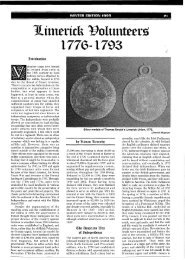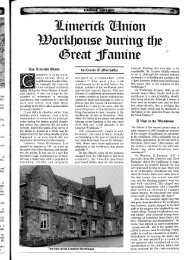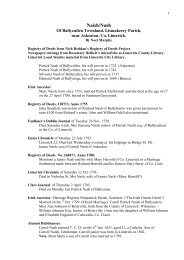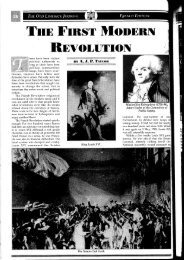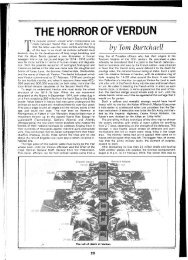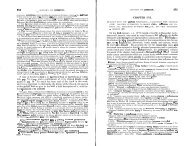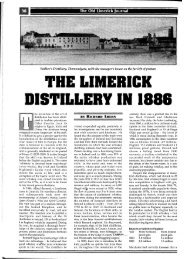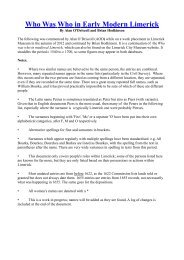The House of Industry by Paddy Lysaght - Limerick City Council
The House of Industry by Paddy Lysaght - Limerick City Council
The House of Industry by Paddy Lysaght - Limerick City Council
You also want an ePaper? Increase the reach of your titles
YUMPU automatically turns print PDFs into web optimized ePapers that Google loves.
suggest that people were <strong>of</strong>ten forced into the institution,<br />
simply because they were unable to find work outside.<br />
T.\e temptation must have been there to recruit sturdy<br />
people who could work rather than the aged poor and<br />
deserted children. It would appear that young females<br />
out <strong>of</strong> work were also sent to the institution for the<br />
strange and illogical reason that they might otherwise<br />
fall <strong>by</strong> the wayside.<br />
For ten or fifteen years after the <strong>House</strong> <strong>of</strong> <strong>Industry</strong><br />
opened it would appear that life was tolerable enough for<br />
the inmates. <strong>The</strong> funds for its support from the grand<br />
juries' presentments, plus several donations and sub-<br />
scriptions, were more or less adequate. Ferrar gives the<br />
following details <strong>of</strong> the inmates for the year 1787; aged<br />
and infirm 41 ; poor, able to work, 35; lunatics 12: in all,<br />
88. <strong>The</strong> pre-Famine increase in the population <strong>of</strong> the city<br />
inevitably meant an increase in the population <strong>of</strong> the<br />
<strong>House</strong> <strong>of</strong> <strong>Industry</strong> as well. In 1827 we find it contained 450<br />
inmates, who, despite some additions to the original<br />
building, were now "crowded to excess, and the yards for<br />
exercise encroached on to such a degree, as to contract<br />
them beyond what they should be in point <strong>of</strong> space". And<br />
because the adjacent lands were Church property or in<br />
private hands, there was no possibility <strong>of</strong> purchasing<br />
further ground for enlar ing the institution.<br />
As early as 1801 we fin d that Rev. Foster Archer, in his<br />
capacity as His Majesty's Inspector <strong>of</strong> Prisons, visited<br />
the house and reported:<br />
... <strong>The</strong> <strong>House</strong> <strong>of</strong> <strong>Industry</strong>, where an inhuman practice<br />
prevails <strong>of</strong> putting chains and heavy logs on vagrants,<br />
sick and well, industrious and idle, orderly or riotous.<br />
I had those chains removed from the diseased and the<br />
industrious and well behaved. This . . . . . . . .<br />
practice <strong>of</strong> chaining human creatures is very<br />
reprehensible. It covers an oppressive system <strong>of</strong><br />
making the wretched beings pay the Beadle for tak-<br />
ing them <strong>of</strong>f.<br />
Shades <strong>of</strong> Dickens, but it would appear that the beadles<br />
he portrayed in his writings never stooped as low as their<br />
counterpart in the <strong>House</strong> <strong>of</strong> <strong>Industry</strong>.<br />
In 1805 Sir John Carr in his Tour <strong>of</strong> Ireland described<br />
his visit to <strong>Limerick</strong>, and he found the <strong>House</strong> <strong>of</strong> <strong>Industry</strong>,<br />
"A gloomy abode <strong>of</strong> mingled want, disease, vice and<br />
malady, where lunatics were loaded with heavy chains<br />
and fallen women bound and logged".<br />
By, 1828 the conditions <strong>of</strong> the inmates would ap ear to<br />
have improved, if we take the words <strong>of</strong> Elizabeth d' ry, the<br />
great prison reformer at their face value. In that year she<br />
and her brother visited the house, and in the words <strong>of</strong> her<br />
brother, "Visited this useful institution in company with<br />
my sister, Elizabeth Fry, and we are much pleased with<br />
it. It appears extremely desirable that the worthy klderman's<br />
Watson's efforts should be yet more extensively<br />
supported ..." Andrew Watson was, apparently, a consistent<br />
worker on behalf <strong>of</strong> the house.<br />
An 1825 report on the independent schools in <strong>Limerick</strong><br />
showed that there were two schools, sponsored <strong>by</strong> the<br />
Protestant Kildare Place Society, in the house. Seventytwo<br />
girls and seventy-one boys were being educated there.<br />
From a statement <strong>of</strong> the income and expenditure <strong>of</strong> the<br />
house in 1840 we learn that there were 567 people in the institution.<br />
At this date it was over £700.00 in debt and the<br />
governors made an appeal to the grand juries to<br />
sum adequate to the support <strong>of</strong> this excellent c $ant arity". "a<br />
But such an amount was not forthcoming. In the previous<br />
year, presentments from the city and county, pJus donations<br />
only came to over £1,200.00 - a pitiful sum when<br />
one remembers that there were more than 500 inmates to<br />
be cared for. An examination <strong>of</strong> the income and expenditure<br />
<strong>of</strong> the house for 1839-'40 is so interesting that it is<br />
W<br />
worth giving in full. (See appendix).<br />
Some <strong>of</strong> the rules <strong>of</strong> the house bring home the<br />
harshness and poverty <strong>of</strong> the times. At night fall a bell<br />
was rung, when all the inmates had to retire to their<br />
respective wards, where they were locked up until morn-<br />
ing. After a breakfast <strong>of</strong> porridge and new milk, all the<br />
able-bodied went to their respective occupations - weav-<br />
ing, spinning, opening up hair for upholsterers and oakum<br />
for ship chandlers. A third <strong>of</strong> the pr<strong>of</strong>it from these<br />
l



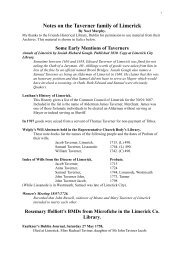

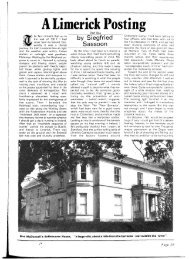
![The Galbally farmer [poem] by Darby Ryan - Limerick City Council](https://img.yumpu.com/24792577/1/190x260/the-galbally-farmer-poem-by-darby-ryan-limerick-city-council.jpg?quality=85)
